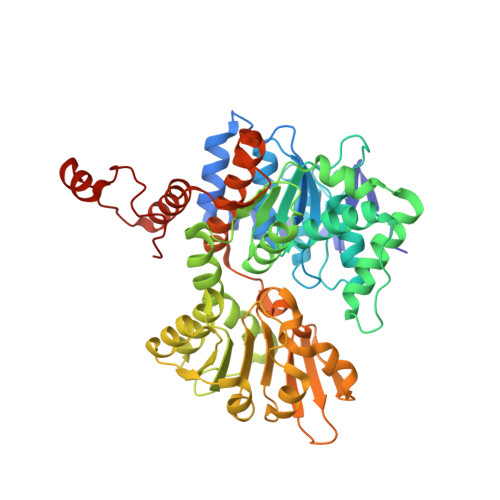Crystal structures of Mycobacterium tuberculosis S-adenosyl-L-homocysteine hydrolase in ternary complex with substrate and inhibitors.
Reddy, M.C., Kuppan, G., Shetty, N.D., Owen, J.L., Ioerger, T.R., Sacchettini, J.C.(2008) Protein Sci 17: 2134-2144
- PubMed: 18815415
- DOI: https://doi.org/10.1110/ps.038125.108
- Primary Citation of Related Structures:
2ZIZ, 2ZJ0, 2ZJ1, 3CE6, 3DHY - PubMed Abstract:
S-adenosylhomocysteine hydrolase (SAHH) is a ubiquitous enzyme that plays a central role in methylation-based processes by maintaining the intracellular balance between S-adenosylhomocysteine (SAH) and S-adenosylmethionine. We report the first prokaryotic crystal structure of SAHH, from Mycobacterium tuberculosis (Mtb), in complex with adenosine (ADO) and nicotinamide adenine dinucleotide. Structures of complexes with three inhibitors are also reported: 3'-keto aristeromycin (ARI), 2-fluoroadenosine, and 3-deazaadenosine. The ARI complex is the first reported structure of SAHH complexed with this inhibitor, and confirms the oxidation of the 3' hydroxyl to a planar keto group, consistent with its prediction as a mechanism-based inhibitor. We demonstrate the in vivo enzyme inhibition activity of the three inhibitors and also show that 2-fluoradenosine has bactericidal activity. While most of the residues lining the ADO-binding pocket are identical between Mtb and human SAHH, less is known about the binding mode of the homocysteine (HCY) appendage of the full substrate. We report the 2.0 A resolution structure of the complex of SAHH cocrystallized with SAH. The most striking change in the structure is that binding of HCY forces a rotation of His363 around the backbone to flip out of contact with the 5' hydroxyl of the ADO and opens access to a nearby channel that leads to the surface. This complex suggests that His363 acts as a switch that opens up to permit binding of substrate, then closes down after release of the cleaved HCY. Differences in the entrance to this access channel between human and Mtb SAHH are identified.
- Department of Biochemistry and Biophysics, Texas A&M University, College Station, Texas 77843-2128, USA.
Organizational Affiliation:


















